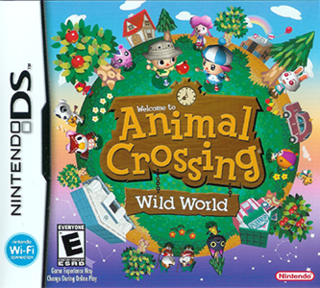
Animal Crossing: Wild World is a 2005 social simulation video game developed and published by Nintendo for the Nintendo DS handheld game console. It was released in Japan in November 2005, in North America and Australia in December 2005, and in Europe in March 2006. It is the second installment in the Animal Crossing series, and the sequel to Animal Crossing on the GameCube.

Nintendogs, styled as "nintendogs", is a real-time pet simulation video game developed and published by Nintendo for the Nintendo DS handheld video game console. It was released in Japan, and was later released in: North America, Australia, New Zealand, Europe and other regions. It was originally released in three different versions: Dachshund & Friends, Lab & Friends and Chihuahua & Friends. It has been re-released twice, first as a bundled release with a special edition Nintendo DS with a new version called Nintendogs: Best Friends and later as Nintendogs: Dalmatian & Friends.
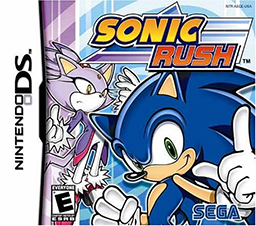
Sonic Rush is a 2005 platform game developed by Sonic Team and Dimps for the Nintendo DS as part of Sega's Sonic the Hedgehog series. It was released on November 15, 2005, in North America, November 18 in the PAL region, and November 23 in Japan, and was the final game in the mainline Sonic series to be produced by Yuji Naka before his departure from Sega. It is a 2D platform game, similar to earlier games in the series like Sonic Advance, as well as later ones like Sonic Mania. Levels in the game are side-scrolling and displayed using both of the DS's screens. However, boss battles, the main characters, and a special stage are rendered in 3D, creating a 2.5D effect. The game's storyline follows the intertwining adventures of the series' main character, Sonic the Hedgehog and a new character, Blaze the Cat. They respectively battle Doctor Eggman and his doppelgänger Eggman Nega at certain points.

Urban Champion (アーバンチャンピオン) is a fighting video game developed and published by Nintendo in 1984. It was first released for the Famicom and Nintendo VS. System for arcades in 1984, and later released for the Nintendo Entertainment System in North America and Europe in 1986. It was inspired by the 1984 Game & Watch game Boxing. It is Nintendo's first 2D fighting game, eventually followed in 1993 by Joy Mech Fight, released exclusively in Japan for the Famicom.

Brain Age: Train Your Brain in Minutes a Day!, known as Dr. Kawashima's Brain Training: How Old Is Your Brain? in PAL regions, is an edutainment puzzle video game. It was developed and published by Nintendo for the Nintendo DS. Nintendo has stated that it is an entertainment product inspired by Tohoku University professor Ryuta Kawashima's work in the neurosciences.

Brain Age 2: More Training in Minutes a Day!, known as More Brain Training from Dr Kawashima: How Old Is Your Brain? in PAL regions, is an edutainment puzzle game and the sequel to Brain Age: Train Your Brain in Minutes a Day! (2005). It was developed and published by Nintendo for the Nintendo DS handheld game console. Before the game begins, the player must perform a Brain Age Check to determine their brain age, which ranges from 20 to 80, to determine approximately their brain's responsiveness. A brain age of 20, the lowest age that the player can achieve, indicates that the player's brain is as responsive as that of an average 20-year-old. After the player is told their initial brain age, they can complete a series of minigames to help improve their brain's responsiveness, after which they can run Brain Age Check again to determine their updated brain age.

Mind Quiz, also known as Mind Quiz: Exercise Your Brain or Mind Quiz: Your Brain Coach, is a mental training game for the Nintendo DS and PlayStation Portable. It is similar to Nintendo's Brain Age: Train Your Brain in Minutes a Day! It involves playing different training exercises to measure and improve particular parts of the player's brain, such as one's brain age and its brain stress degree.
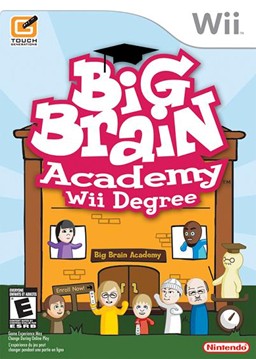
Big Brain Academy: Wii Degree, known in PAL regions as Big Brain Academy for Wii, is a video game released for the Wii. A sequel to the game Big Brain Academy for the Nintendo DS, it too measures a player's brain's weight, but with new games and puzzles to solve. The game makes use of Miis and uses WiiConnect24 features, allowing competition amongst users' friends, whose codes are automatically imported from the Wii's internal address book.
Minna de Kitaeru Zenno Training is an arcade game released only in Japan by Namco Bandai Games on December 21, 2006.

Wii Fit is a 2007 exergaming video game designed by Nintendo's Hiroshi Matsunaga for the Wii home video game console, featuring a variety of yoga, strength training, aerobics, and balance mini-games for use with the Wii Balance Board peripheral. Matsunaga described the game as a "way to help get families exercising together". It has since been adopted by various health clubs around the world, and has previously been used for physiotherapy rehabilitation in children and in nursing homes to improve posture in the elderly.

Link's Crossbow Training is a shooting video game developed and published by Nintendo for the Wii video game console. It was bundled with the Wii Zapper peripheral and was the first title to use it. The game was released worldwide in 2007, and in Japan in May 2008. It uses several environments, enemies, and other assets from The Legend of Zelda: Twilight Princess as stages for targets with various shootable background objects.
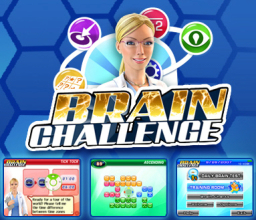
Brain Challenge is a mental exercise video game, featuring "brain exercise puzzles". The game was developed by Gameloft Beijing for mobile phone and iPod and released on September 5, 2007. In 2008 was followed by a Nintendo DS version on January 8, an Xbox Live Arcade release on March 12, and a PlayStation 3 launch on November 27. The N-Gage 2.0 version was released on the day of the service's launch, April 3, 2008. A version for WiiWare was released in autumn 2008 on all three regions. The Wii version also uses Miis for the players profile. OnLive also had launched their new streaming game platform with Brain Challenge on July 27, 2010. The game was released for Mac OS X in January 2011.
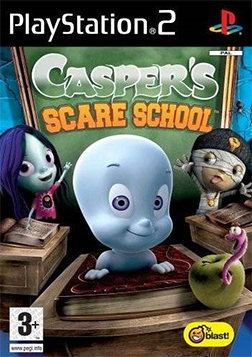
Casper's Scare School is an adventure video game developed by Data Design Interactive for the PlayStation 2 and Nikitova Games for the Nintendo DS. The game was released in Europe in 2008 and in North America in 2010. It reuses similar assets to its 2006 predecessor, Casper and the Ghostly Trio, which was only released in Europe. A sequel titled Casper's Scare School: Spooky Sports Day was released for the Nintendo DS and Wii in Europe in 2009 and North America in 2010.

Brain Age Express are three educational puzzle video games developed by Nintendo for the Nintendo DSi's DSiWare download service. They are the third series of games in the Brain Age series, and are repackaged versions of both Brain Age: Train Your Brain in Minutes a Day! and Brain Age 2: More Training in Minutes a Day! games, featuring both old and new puzzles.
Brain Age, known as Dr Kawashima's Brain Training in PAL regions, is a series of video games developed and published by Nintendo, based on the work of Ryuta Kawashima.

Brain Age: Concentration Training,JPN known in Europe and Australia as Dr Kawashima's Devilish Brain Training: Can you stay focused?, is an educational puzzle video game developed and published by Nintendo. It is the fourth major entry in the Brain Age series and the first made specifically for the Nintendo 3DS. It was released in Japan on July 28, 2012, in North America on February 10, 2013, and in South Korea on September 5, 2013. It later came to Europe on July 28, 2017, and Australia on July 29, 2017, five years apart from the initial release. Dr. Kawashima presents the game's purpose as being to counter prevalent subpar concentration skills onset by social media and other aspects of modern life.

Dr Kawashima's Brain Training for Nintendo Switch is an edutainment puzzle video game developed by Nintendo and indieszero and published by Nintendo for the Nintendo Switch. It is the fifth entry in the Brain Age puzzle video game series, based on the research of neuroscientist Ryuta Kawashima, whose avatar guides the player through the game. It was released on December 27, 2019 in Japan, January 3, 2020 in Europe and Australia, and July 1, 2020 in South Korea. The game was not released in North America.

Big Brain Academy is a puzzle video game published and developed by Nintendo for the Nintendo DS handheld video game console. It was released in Japan on June 30, 2005, and subsequently in other regions in summer 2006. The game was planned to be released in China for the iQue DS system and appeared in the system's trailer, but it remained unreleased. It has been compared to Brain Age: Train Your Brain in Minutes a Day!. It was marketed under Nintendo's Touch! Generations brand. A sequel, Big Brain Academy: Wii Degree, was released on the Wii in April 2007.

Big Brain Academy is a series of puzzle video games developed and published by Nintendo. Similar to the Brain Age series, each game features a number of activities designed to test, measure, and improve the player's mental skills. The first two games were released under the Touch! Generations brand, which has since been discontinued.

















